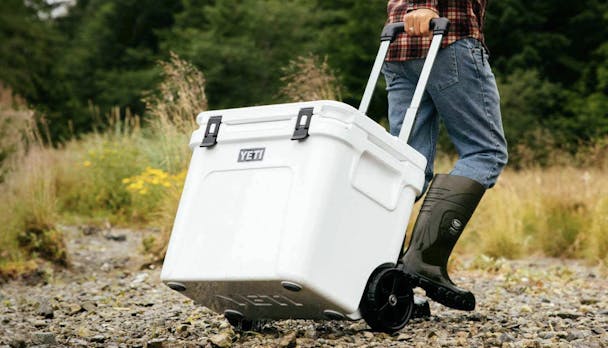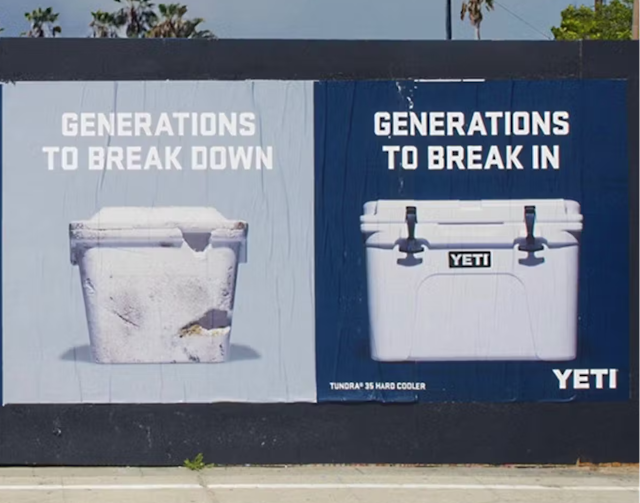Yeti CMO on how he’ll never cede control to ‘the whims of influencers and celebs’
The Texas-based outdoor brand doesn’t give freebies to the famous or pay lifestyle influencers to promote its products. Instead, says marketing boss Paulie Dery, it partners with interesting personalities embedded in the communities it supports.

How Yeti stays true to its outdoor audience / Yeti
Yeti, the maker of coolers and outdoor gear, initially built its name among the fishing and ranching communities in the US backcountry. More recently, however, it has entered the cultural zeitgeist and begun to pop up in international markets.
Chief marketing officer Paulie Dery is well aware of its growing cultural credentials but tells The Drum he is extremely cautious not to “pander” to trends for a quick buck and risk damaging the brand in the long run.
“If you are at the whim of influencers, TikTok or celebrities,” he says, “you are not 100% controlling the narrative of your brand – and that is terrifying. I love that celebrities love us and that they want to do stuff with us, but is that good for us long term? No, I don’t think so.”
Advertisement
There are so many examples of brands that shot to fame from a celebrity or influencer endorsement and then struggled with their identity after the trend died down. Paris Hilton made the Von Dutch cap a cultural phenomenon, moving the brand away from its surfing roots, while skate brand Vans faced a similar identity crisis when the Kardashians adopted its Old Skool shoe.
“You can’t chase trends and TikTok dances; if it ain’t you, it ain’t you and I think people respect that in the long run,” is how Dery sees it. “So holding strong on what we say ’no’ to is super important.”
Yeti’s strategy has been to forge ties with communities that have organically embraced its products, like surfers and skaters, as well as the BBQ community. It has a roster of around 200 ambassadors who aren’t household names but are well-known within the communities Yeti is already affiliated with.
“You have to give a lot of credit to the people who make up your core; they want to represent you, they want to use your stuff and tell the world about you. You need to keep investing in them.”
Advertisement
When entering a new community, the Yeti team will show up at grassroots events to forge mutually beneficial partnerships with its ambassadors. “They are the ultimate barometer and info on the ground.”
As an example, Yeti joined the tight-knit surfing community by partnering with surf filmmakers who “helped navigate those waters“ and made sure the brand was “dealing with the right people.” Now, Yeti is the official sponsor of the World Surf League.
“People invented coolers before we did, so we focus on the brand expression. It is a lifestyle, a way of life, and we celebrate those communities who are out in the wild doing what they do. We’re diligent at staying true to that message.”
Investing in content that makes no financial sense
Along with the ambassador program, another tentpole of Dery’s marketing strategy is long-form content, which he admits “doesn’t make financial sense” but says is a way to engage customers and introduce the outdoors to curious minds.
Its YouTube series ’Yeti Presents’ profiles athletes, while ’Color Inspired by True Events’ spotlights the work of grassroots organizations and ’Yeti Dispatch’ tells the stories of cultures and places. Its ’Year in Review’ campaign with Code and Theory, which generated personalized videos for customers to plan their adventures for the year ahead, recently won The Drum Award for Creativity.
“If you make content that is enjoyable and relevant, it doesn’t matter what length or where it is, it works,” he says. “A larger audience watches them not because they are interested in the subject, but because their minds get opened to the wild – I can’t prove the return on that.”
Suggested newsletters for you
Yeti also has an endemic print strategy to place ads and sponsored content in niche publications. “It shows that we are embedded and supportive of that community; if we don’t buy print ads in those mags, that mag may fold.”
Then there is out-of-home, which Dery says is “a fun medium to play with.” A recent poster campaign focused on the durability of Yeti products by comparing them with alternatives and Dery says out-of-home has the ability to be both brand marketing and product marketing. “Most people look at our ads and think that is great brand advertising, but I don’t know why product ads can’t look like brand ads.”
Surviving the next 200 years

Yeti is extremely protective over its brand narrative, says Dery. “We have enormous fortitude to protect our brand at all costs and we have a mindset that isn’t about the next two years, it’s about the next 200.”
One of its key drivers for entering the UK market was its team had started to see Yeti products appear in places they didn’t expect. “We all thought, ‘Hey, are we controlling our narrative over there?’ So we got set up there so we are in control of the narrative of where we’re being seen and who’s using us because that’s important to us.”
For its European expansion, Dery and his team are eyeing up the equestrian and golfing communities. “These are communities that we wouldn’t have thought were Yeti communities, but where we are now starting to run our playbook in.”
Dery credits the Yeti leadership team for giving him the space to scale slowly without the pressure of quick sales. “The minute you’re in a daily commodity fight is the minute the brand’s in trouble and hasn’t done its job. Then you are just looking for viral hits and trying to get the brand out there, jumping on a TikTok trend as opposed to people believing in what you are and what you stand for.”

